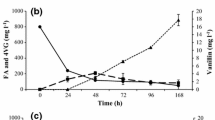Abstract
A bacterium designated as HS8 was newly isolated from soil based on its ability to degrade isoeugenol. The strain was identified as Bacillus subtilis according to its 16S rDNA sequence analysis and biochemical characteristics. The metabolic pathway for the degradation of isoeugenol was examined. Isoeugenol-diol, for the first time, was detected as an intermediate from isoeugenol to vanillin by a bacterial strain. Isoeugenol was converted to vanillin via isoeugenol-diol, and vanillin was then metabolized via vanillic acid to guaiacol by strain HS8. These metabolites, vanillin, vanillic acid, and guaiacol, are all valuable aromatic compounds in flavor production. At the same time, the bipolymerization of isoeugenol was observed, which produced dehydrodiisoeugenol and decreased the vanillin yield. High level of vanillic acid decarboxylase activity was detected in cell-free extract. These findings provided a detailed profile of isoeugenol metabolism by a B. subtilis strain for the first time, which would improve the production of valuable aromatic compounds by biotechnology.






Similar content being viewed by others
References
Abraham WR, Arfmann HA, Stumpf S, Washausen P, Kieslich K (1988) Microbial transformations of some terpenoids and natural compounds. In: Schreier P (ed) Bioflavour ‘87. Analysis, biochemistry, biotechnology. W. de Gruyter, Berlin, pp 399–414
Bradford WW (1976) A rapid and sensitive method for the quantitation of microgram quantities of protein utilizing the principle of protein-dye binding. Anal Biochem 72:248–254
Chatterjee T, De BK, Bhattacharyya DK (1999) Microbial conversion of isoeugenol into vanillin by Rhodococcus rhodochrous. Indian J Chem Sect B 38:538–541
Chow KT, Pope MK, Davies J (1999) Characterization of a vanillic acid non-oxidative decarboxylation gene cluster from Streptomyces sp. D7. Microbiology 145:2393–2403
Herrmann WA, Weskamp T, Zoller JP, Fischer RW (2000) Methyltrioxorhenium: oxidative cleavage of CC-double bonds and its application in a highly efficient synthesis of vanillin from biological waste. J Mol Catal A Chem 153:49–52
Holt JG, Krieg NR, Sneath PHA, Staley JT, Williams ST (1994) Bergey’s manual of determinative bacteriology. Lippincott Williams & Wilkins, Philadelphia, PA, pp 559–564
Huang Z, Dostal L, Rosazza JPN (1994) Mechanism of ferulic acid conversion to vanillic acid and guaiacol by Rhodotorula rubra. J Biol Chem 268:23594–23598
Juhasz L, Kurti L, Antus S (2000) Simple synthesis of benzofuranoid neolignans from Myristica fragrans. J Nat Prod 63:866–870
Li T, Rosazza JPN (2000) Biocatalytic synthesis of vanillin. Appl Environ Microbiol 66:684–687
Müller B, Münch T, Muheim A, Wetli M (1998) Process for the production of vanillin. European Patent 0,885,968
Overhage J, Priefert H, Rabenhorst J, Steinbüchel A (1999) Biotransformation of eugenol to vanillin by a mutant of Pseudomonas sp. strain HR199 constructed by disruption of the vanillin dehydrogenase (vdh) gene. Appl Microbiol Biotechnol 52:820–823
Overhage J, Steinbüchel A, Priefert H (2003) Highly efficient biotransformation of eugenol to ferulic acid and further conversion to vanillin in recombinant strains of Escherichia coli. Appl Environ Microbiol 69:6569–6576
Priefert H, Rabenhorst J, Steinbüchel A (2001) Biotechnological production of vanillin. Appl Microbiol Biotechnol 56:296–314
Rabenhorst J, Hopp R (1991) Process for the preparation for vanillin. US Patent 5,017,388
Rabenhorst J, Hopp R (1996) Process for the preparation of vanillin and microorganisms suitable therefor. US Patent 6,133,003
Rao RS, Ravishankar GA (1999) Biotransformation of isoeugenol to vanilla flavour metabolites and capsaicin in suspended and immobilized cell cultures of Capsicum frutescens: study of the influence of β-cyclodextrin and fungal elicitor. Process Biochem 35:341–348
Santos AS, Pereira JRN, da Silva IM, Sarquis MIM, Antunes OAC (2004) Peroxidase catalyzed microbiological oxidation of isosafrol into piperonal. Process Biochem 39:2269–2275
Shimoni E, Ravid U, Shoham Y (2000) Isolation of a Bacillus sp. capable of transforming isoeugenol to vanillin. J Biotechnol 78:1–9
Shimoni E, Baasov T, Ravid U, Shoham Y (2002) The trans-anethole degradation pathway in an Arthrobacter sp. J Biol Chem 277:11866–11872
Shimoni E, Baasov T, Ravid U, Shoham Y (2003) Biotransformations of propenylbenzenes by an Arthrobacter sp. and its t-anethole blocked mutants. J Biotechnol 105:61–70
Ten Have R, Rietjens IM, Hartmans S, Swarts HJ, Field JA (1998) Calculated ionization potentials determine the oxidation of vanillin precursors by lignin peroxidase. FEBS Lett 430:390–392
Zhao LQ, Sun ZH, Zheng P, Zhu LL (2005) Biotransformation of isoeugenol to vanillin by a novel strain of Bacillus fusiformis. Biotechnol Lett 27:1505–1509
Acknowledgements
The authors gratefully acknowledge the financial support of this work by Shanghai Apple Flavor & Fragrance (China). The work was supported in part by the grant from the State Key Foundation of the Ministry of Education of China (grant no. 106102).
Author information
Authors and Affiliations
Corresponding author
Rights and permissions
About this article
Cite this article
Zhang, Y., Xu, P., Han, S. et al. Metabolism of isoeugenol via isoeugenol-diol by a newly isolated strain of Bacillussubtilis HS8. Appl Microbiol Biotechnol 73, 771–779 (2006). https://doi.org/10.1007/s00253-006-0544-x
Received:
Revised:
Accepted:
Published:
Issue Date:
DOI: https://doi.org/10.1007/s00253-006-0544-x




